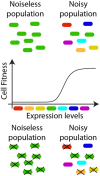Phenotypic Variability in Synthetic Biology Applications: Dealing with Noise in Microbial Gene Expression
- PMID: 27092132
- PMCID: PMC4824758
- DOI: 10.3389/fmicb.2016.00479
Phenotypic Variability in Synthetic Biology Applications: Dealing with Noise in Microbial Gene Expression
Abstract
The stochasticity due to the infrequent collisions among low copy-number molecules within the crowded cellular compartment is a feature of living systems. Single cell variability in gene expression within an isogenic population (i.e., biological noise) is usually described as the sum of two independent components: intrinsic and extrinsic stochasticity. Intrinsic stochasticity arises from the random occurrence of events inherent to the gene expression process (e.g., the burst-like synthesis of mRNA and protein molecules). Extrinsic fluctuations reflect the state of the biological system and its interaction with the intra and extracellular environments (e.g., concentration of available polymerases, ribosomes, metabolites, and micro-environmental conditions). A better understanding of cellular noise would help synthetic biologists design gene circuits with well-defined functional properties. In silico modeling has already revealed several aspects of the network topology's impact on noise properties; this information could drive the selection of biological parts and the design of reliably engineered pathways. Importantly, while optimizing artificial gene circuitry for industrial applications, synthetic biology could also elucidate the natural mechanisms underlying natural phenotypic variability. In this review, we briefly summarize the functional roles of noise in unicellular organisms and address their relevance to synthetic network design. We will also consider how noise might influence the selection of network topologies supporting reliable functions, and how the variability of cellular events might be exploited when designing innovative biotechnology applications.
Keywords: biological noise; intrinsic/extrinsic stochasticity; network topology; standard biological parts; synthetic biology.
Figures


 dead;
dead;  alive. The reader is referred to (Smits et al., 2006) for additional examples.
alive. The reader is referred to (Smits et al., 2006) for additional examples.References
Publication types
LinkOut - more resources
Full Text Sources
Other Literature Sources

